



This article reflects on the hopes of Cyberfeminism in response to ‘Revisiting the Future: Technofeminism in the 21st Century‘, a panel discussion between Mindy Seu, Cornelia Sollfrank, Judy Wajcman, and chair Marie Thompson. This conversation took place on the 5th of October 2019 at the Barbican Centre in London, UK, as part of New Suns: A Feminist Literary Festival.

BIG DADDY MAINFRAME
“What’s so special about Lisa? Oh, I’ve had a lot of computers, but my Lisa is different: she works the way I do”
Apple Lisa, video infomercial, 1983
Men, like gods, have always had a thing for creating entities in their own image. Gods create men, men will gods into existence. Men create tools, tools make men in turn. But what if the creator of technology is often a man, and a very specific kind of man? What are, then, the ways in which gender and technology construct one another?
Since the dawn of computation, men found it appealing to automate away the predictable and repetitive labour, often embodied and performed by women. In other words, technology has contributed (among a lot of other things) to the automation of traditional “women’s work”, and it did so on men’s terms [1]. From the Girl-less, Cuss-less Phone, the first automated dial system (1892), to Lisa, the first personal Apple Computer (1983), to Siri and Alexa, digital assistants, (2011 and 2014), the designs of and designs for the pater ex machina have set the bar for the height of technological progress.
Cyberfeminism is a feminist genre that addresses questions of gender and technology while bringing their implications to the fore. Automation is not the only nor the central theme of Cyberfeminism: academics, activists, hackers, artists, women, and non-women tied to this genre, engage with broad questions of gender and technology based on the assumptions that:
Largely, grounded in Donna Haraway’s A Cyborg Manifesto, Cyberfeminism as a movement was formally articulated in 1991 by the Adelaide based artist collective VNS Matrix. VNS designed a billboard titled “A Cyberfeminist Manifesto for the 21st Century” depicting horned bodies, psychedelic vulvas and reciting: “[…]we are the virus of the new world disorder rupturing the symbolic from within; saboteurs of big daddy mainframe; the clitoris is a direct line to the matrix.” That said, the origins of the genre can be traced more accurately as a decentralised global emergence. Cyberfeminism has come to life more like a granular collection of scattered raw data, and less like a single revelation happened at a defined point in time.
In the panel Revisiting the Future: Technofeminisms in the 21st Century, Mindy Seu, Cornelia Sollfrank, Judy Wajcman and Marie Thompson discussed the state of Cyberfeminism today.
ATTESTING TO THE REVIVAL
Chair Marie Thompson points out how, in the past decade, there seems to be a reinvigorated tendency for questions of Cyberfemnism. The increased mainstreaming of concerns around gender and technology in institutional contexts such as Girls Who Code, Women in Tech Festival, and countless diversity initiatives in tech companies are clear examples. To Thomson, the main question is “why should we struggle for Cyberfeminism now?”
“Silicon Valley can do [diversity inclusion campaigns]” says Judy Wajcman, “that’s fine, but what is the kind of big-scale change that must occur at institutional level?”. Wajcman emphasised how important it is to embed inclusion into the fabric of tech companies’ culture rather than it remaining a CSR exercise, or better, rather than supporting and reinforcing existing liberal frameworks.
According to Mindy Seu, Cyberfeminism revival is largely due to the need of big institutions to accumulate cultural capital which is often articulated in superficial measures such as cosmetic diversity initiatives. For Seu, similarly to Wajcman, the main question is ”how can we see feminist values embedded in the ethos of companies?”. Seu also points out how the ascension of women in big cultural (and tech) institutions are often not only hindered by the notorious “glass ceiling”, but also deliberately sabotaged through the so-called “glass cliff”. A glass cliff is a term used to describe a situation where a woman is nominated head of an organisation which is already crumbling. The intention is to signal externally that this organisation is making efforts to get back on track, or make amends for its corrupted past by hiring someone with a perceived higher ethical value. By doing so, the board actively sets up this woman (or anyone, really) to fail, because the organisation has larger structural problems that no person alone can solve (see recent board allegations concerning MIT Media Lab).
“It is as if nothing has happened in between the 90s and now,” Cornelia Sollfrank says. “This means that things [gender inequality within the tech industry] are staying the same, and maybe getting worse… These, mostly young, very young, women do not understand the historical precedents of Cyberfeminism.” While she seems to partially dismiss this revival as a fashion statement, her book ‘The Beautiful Warriors. Technofeminist Praxis in the Twenty-First Century’ sets out to counter this trend by connecting up the insights and practices of 90’s cyberfeminism with new techno-eco-feminists as part of an ongoing social and aesthetic activism.
RE-MAKING THE INTERNET
“This is not a book about women and technology. Nor was this book created for women. Throughout these pages, scholars, hackers, artists, and activists of all regions, races, sexual orientations, and genetic make-ups consider how humans might reconstruct themselves by way of technology. What is a woman anyway?”
Intro from Cyberfeminism Catalog 1990-2020, Mindy Seu, Harvard University Graduate School of Design, 2019
One strategy to challenge the dominant narrative of men as sole creators and geniuses, argues Seu, is to incorporate women’s voices in the history of computation. As she puts it: “We are taught to focus on engineering, the military-industrial complex, and the grandfathers who created the architecture and protocol. But the internet is not only a network of cables, servers, and computers. It is an environment that shapes and is shaped by its inhabitants.” In her Cyberfeminist index, Seu traces a detailed and precise overview of the diverse body of today’s practices.
Across the panel, there seemed to be a shared awareness of differences in terms of references, strategies, culture, and visual cultures among current activists and academic groups and across generations. One example that stands out is the South Korean Cyberfeminist group Megalia whose main strategy for activism has been online trolling. Looking at their logo, a hand making the gesture to indicate a man’s penis size, it is not hard to understand their style of communication. Megalia could be dismissed as a funny and naive case, but there are deep reasons why South Korean women have implemented such a strategy. For instance, feminism has only entered the public sphere less than a decade ago.
As Judy Wajcman points out, the dominant narratives in feminist discourse are set up by Western standards. For instance, in South America, she notes, Donna Haraway is not as strong an academic reference as in the West. Wajcman also argues that Haraway’s texts, despite advocating for socialist feminism and having strong political agendas, often lack the clarity and simplicity to be accessed by anyone who does not belong to the hyper educated Western academia elite. Seu points the attention towards the fact that Haraway supposedly decided to use contrived language intentionally (as a hack), in order to be deemed interesting and relevant in academic context.
THE OTHER
Cyberfeminism is relevant today more than ever when addressing topics of responsibility, agency, materiality, care, and anthropocentrism. In this sense, Cyberfeminism today transcends identity politics: it becomes an essential cultural tool with respect to survival, equality, and sustainability.
Cyberfeminism can be defined as “a genre of contemporary feminism which foregrounds the relationship between cyberspace, the Internet and technology.” [3]
To foreground is the action of pushing objects that are necessary in the background to the fore. That is bringing the hidden, compounded, interchangeable, opaque to a position that is close enough to the viewer to be observed. In other words, turning the distant and neglected “other” into voices and materials that can be seen, heard, interrogated.
To bring the back to the fore is, on the one hand, to question men’s protagonism, self- importance, and arrogance, thus attempting to dismantle not only the centrality of men as male humans, but that of humanity as a whole. Anthropocentrism has been at the core of technological developments. Humans have predominantly designed for human comfort (with the standard for “human” being effectively set up by men) narrowing down the possibilities of what technologies could be or do.
Complimentarily, foregrounding is also the practice of exposing the material and toxic aspects of technological progress and production both in terms of human labour and ecological implications, from e-waste to amounts of energy voraciously consumed by computational tools and infrastructures, to labour-heavy mining of rare earth minerals.
In stark contrast with the early days of eco-feminism which was expressively anti-technology, the panel maps out emerging strands of (techno) eco-feminism that critically engage with questions of gender, cyberspace, and ecology from a holistic perspective. This approach is not in opposition of technological tools, but rather in conversation with them. In this sense, techno-eco-feminism is close to the Haraway’s idea of questioning scientific methods not with the goal to invalidate them, but rather to ask “what are ways in which science can be used for emancipatory purposes?”
Featured Image:
Artwork by Cecilia Serafini
from New Suns Festival 2019
Header Image:
Screenshot of Siri by Chiara Di Leone
The English tranlsation of The Beautiful Warriors. Technofeminist Praxis in the Twenty-First Century, edited by Cornelia Sollfrank. Can be found here – http://www.minorcompositions.info/?p=976 and all decent book retailers.
Techno-feminisms are, once again, on the ascent. The Xenofeminist Manifesto, published in 2015 by the collective Laboria Cuboniks, is a provocative and elaborate example for the renewed exhortation for gendered bodies to merge with technology, rationality and the sciences in order to defeat white supremacist patriarchal capitalism. Cornelia Sollfrank, a practising technofeminist artist with a long history and rich experience in building and contributing to cyber-feminist-net-art platforms and organisations, and Rachel Baker, a former ‘net artist’ currently involved in collaborative feminist performance and writing practices, are curious: What drives the resurrected hype around techno-feminisms? What is new about the future 30 years after Cyberfeminism? Will the current techno-feminist virus take hold? Or has recent history resulted in an aesthetic immunity to the strategy of “seductive semiotic parasites?”
CS: Who is Laboria Cuboniks? How did you meet and why did you decide to work together?
LC: We are currently six women spread across three continents, all coming from different disciplinary backgrounds which gives us access to cover a broader territory of thought than working alone, and also provides us an intensive context for sharing our discrete approaches. We met in 2014 at a summer school in Berlin (Emancipation as Navigation) – which was equally a transdisciplinary affair focusing on developments in neo-rationalism. We decided to work together to address the rather quick, dismissive reactions that were circulating at the time surrounding neo-rationalism and accelerationism, as being de facto (and permanently so) cis-white masculine pursuits. While the historicity of some of these ideas most certainly does fall into that category, the consequences of brushing off things like reason, science, technology, and scalability as being enduringly locked into patriarchal regimes, seemed to us a serious limitation when trying to think an emancipatory politics and its necessary feminisms, fit for an age of planetary complexity.

CS: It hardly needs mentioning that there has been a feminist history of reclaiming reason, science and technology. In your Xenofeminist manifesto (XF) [i] you are alluding to both earlier technofeminist concepts, including cyberfeminism, but also to accelerationist ideas. What is your challenge, if any, adding a feminist agenda to a philosophical project that has largely been based on ignoring gender issues? Would XF have ever come into existence without accelerationism?
LC: Certainly the original Accelerationist Manifesto (MAP) did nothing to address gender politics, in a way mirroring its Marxian tones insofar as Marx himself also ignored gender and the types of labour (specifically care and reproductive labour) associated with a binary gender structure to which females have historically been subject to. MAP was a manifesto, which, by form alone is forthright; cannot address everything and is scant on nuance. Our own manifesto is no different in that regard. What we read from it, rather, was a demand for a scalar approach to leftist politics that can affirmatively face up to our situation systematically – the scope of which necessitates massive collective and collaborative mobilisation (which further entails the de-demonizing of the word ‘power’ as it is often portrayed in purely horizontalist approaches). XF responded to some of the general diagnoses mapped out in the MAP, but in its own terms, and opened up other territories for thought neglected by MAP. It’s instructive here to use this as a fruitful example against the type of puritanism that seems to be plaguing much of leftist efforts of late. When we don’t agree with every point, when we are offended at others, when we put all interpretive emphasis on authors’ biographies, we can end up dismissing entire thought-projects in one shot – rather than working out conceptual / pragmatic weaknesses and directing them, augmenting them otherwise. To be clear this isn’t about being conciliatory and taking every position on board – that would be pure triviality – but it is to say that we on the left desire some general transformations. How can we move beyond the game of ‘being right/superior’, of being locked into certain theoretical dogmatisms, of pissing perimeters around intellectual territories for our personal success in the name of a leftist-fashionability, towards the construction of useful concepts that can honestly respond to our complex reality? None of these concepts will ever be possible by a single ‘heroic’ actor/thinker.

CS: I can understand the desire to leave theoretical dogmatisms behind. This is also what we have tried with the Old Boys Network: to open up the term cyberfeminism and offer a platform where diverse and even contradictory concepts could meet. This entails, however, the problem of creating a common ground which is needed for collective agency… Some of the basic claims of accelerationism – that you are sharing – affirm an emphasis on rationality, universalism and self-mastery as well as the dismissal of traditional leftist political beliefs in micropolitics, direct action, inclusiveness, autonomous zones, politics of localism and horizontalism. Therefore, I’m wondering what agency could mean in a xenofeminist context.
LC: These ‘traditional’ leftist forms are only one side of the coin – the ones you mentioned seem more recent historically speaking, but there is also a long history of counter-hegemonically proportioned leftist activity. The danger in binding a leftist politics strictly and solely to a politics of immediacy (presentness, localisation, horizontalism, etc.) is that it seems ineffective at tackling globally-scaled systemic injustices (both structurally and ideologically), often existing in affective or symbolic form alone. The said, all politics occur in a local form – and that’s why a total dismissal of ‘localism’ does a great disservice to the ultimate task at hand (what we might envision as a postcapitalist turn) – but of course it cannot operate in isolation (as many of those with an investment in localist politics themselves acknowledge). The point is to articulate a politics that has the capacity to move between these scales that are commensurate with global reality, constructing vectors of connectivity that transverse these localisations (not only with regards to humans, but to things and disciplines of knowledge as well). Transiting between such scales (between the concrete here and now, and the untouchable, yet thinkable abstract) is a requirement for 21st century emancipatory politics, involving an expanded conception of ‘specificity’, ‘particularity’ and ‘situatedness’. These have been (and continue to be) crucial, contra-modern concepts developed in-large by feminist, post-colonial, queer and sub-altern discourses, but, like every theoretical proposition, have perspectival limits and require bootstrapping within larger ‘field’ conditions. Every difference or particularity exists in relation to something else, it’s embedded so it cannot be extracted and analysed in isolation. The more complex political question to us seem not only identifying/describing (or locating) a site, particularity or identitarian difference, but looking towards the field context as a kind of glue; that is, to approach the field context in which those situated differences experience structural discrimination or unjust advantages and to contemplate how that field context can be manipulated otherwise.
CS: I see your point, and I think it is exactly the complexity of the global situation which makes it impossible to come up with the one universal theory – which is what you are demanding?
LC: The demand would certainly never be for ‘one’ universal theory, but rather for a new theory of what a universalism on the left could mean today. The concept itself needs to be reformulated if it is to signify a non-totalitarian totality. This is where the metaphor of seeing the universal not as a top-down schematic, but as a type of artificial ‘glue’ that needs to be constructed is useful. The universal needs to be seen more as a kind of hosting condition; it is not ‘there’ to be unveiled; it is not a diagram to plug-into; it is an abstraction we urgently need to create in order for maximal human and non-human solidarities to be forged.

CS: Obviously, these ideas of universalism, totality, abstraction and scaleability are adopted from accelerationism that, nevertheless, remains somehow unaccomplished without gender politics? Is this the reason that you have set out to renew technofeminist thinking?
LC: One of the most pernicious critical reflexes against accelerationism (and we need to be clear we are talking about left-accelerationism) was that it was a Futurism 2.0, based on techno-utopianism and brute, masculine virility. While no one is trying to ‘enlist’ people for the accelerationist cause (some amongst us find the term itself quite misrepresentational to the project it espouses), we felt it was necessary to mine the field in two directions: to see what could be usefully applied to contemporary gender politics, and heighten the techno-feminist lineages of several claims made in the MAP. There are a myriad of points in which accelerationist politics intersect with (and are indebted to) feminist thinkers – as for instance with Judy Wajcman’s insistence that technology will neither save us, nor enslave us; but it requires refined analysis in the context of how it is used. Such a position echoes claims made in the MAP that advocate for an examination of the affordances of particular technologies rather than outright celebration or dismissal. Other thinkers associated with the neo-rationalist strand of left-accelerationism, like Ray Brassier, also tend to reverberate certain historically feminist positions, like the Promethean feminism of Shulamith Firestone when addressing the project of refashioning the human; or his emphasis on the use of abstraction for human cognition which also draws upon someone like Donna Haraway as a response to theoretical limitations ushered in via postmodernist positions.
CS: I guess tracking the feminist lineages of accelerationism could be an adventurous project in itself. For reasons of practicality, let’s stay with one example here. Building on Donna Haraway’s anti-naturalist Cyborg Manifesto (1983)[ii], cyberfeminists claimed to rebuild and repurpose technology in order to apply it for emancipatory purposes. At its core, the Cyborg Manifesto is about deconstructing traditionally Western antagonistic dualisms such as human-animal/machine and physical/non-physical. Haraway shows the taxonomic function of such categorisation and how it has been used to identify and construct “the other” in order to establish unjust power relations. She also emphasizes the importance of new technologies as playing an essential role in addressing, challenging and overcoming these dualisms. How does XF exceed this theoretical framework?
LC: We are quite theoretically aligned to the complexities inherent in Haraway’s work – cyborgian concerns – which examine human/machinic coupling adapted to an age where that coupling isn’t necessarily restricted to silicon chips and hardware, but it equally refers to the very ability to hack one’s biological/endocrine operating system. What we glean from such an understanding, is that we can’t simply ‘invest’ in the virtuality of online being as an emancipatory category unto itself, and we need to focus on how virtuality can be better interfaced with material existence. Furthermore, the sprawl-like functioning of online life has since been consolidated by a movement of deep centralization (mainly one search engine, one shop, one social media platform, etc.), so our collective efforts require systemic consideration. We need to conceive of larger structures of governance/justice that are commensurable with these new couplings; we need to focus on the construction of a milieu where the real and virtual, abstract and concrete couplings are politicized towards an emancipatory horizon.

OBN Readers (1998, 1999, 2001). Available online at www.obn.org
CS: Your manifesto stands in the tradition of a whole series of feminist manifestos like the Manifesto of Futurist Woman (1912), the SCUM Manifesto (1969), the Black women’s Manifesto (1970), the BITCH Manifesto (1972), the Cyberfeminist Manifesto for the 21st Century (1991), any many more [iii]. The cyberfeminist alliance Old Boys Network, however, agreed in 1997, at the end of the first Cyberfeminist International, to undermine the character of a proclamation by publishing an anti-manifesto… Why did you return to the traditional form of a manifesto – including its limitations – while at the same time claiming that what is needed is a refined analysis of technology in the context of how it is used?
LC: The manifesto, above all, gave us a highly compressed form through which to achieve a maximal libidinal engagement with ideas. There’s a reason why this form seems to be proliferating of late across movements; it’s quick to read online and can be readily shareable in snippet form. Those stylistic and factors of dissemination played a crucial role in deciding to write in an aphoristic way. As Sarah Kember puts it in her recent work on “iMedia”, the writing strategies common to manifestos ‘serve as hinge points between description and reinvention, art and activism, critique and creativity, writing about and writing out’. As such, there is still a great deal that the manifesto can do.
CS & RB: This takes us to the question of strategy. You are describing your strategy as the creation of “seductive semiotic parasites,” and we are wondering, if you understand your manifesto as a fictional scenario, or rather as political theory. We noticed, for instance, that you refer to ‘hyperstition’, a term originally employed in the mid-90’s to describe auto-loading ad windows during the delay incurred when the browser loads the main content – i.e what happens in the gaps created by the central activity. More latterly, it was used as an allusion to the practices of computer-based networked literatures (cf Simon Biggs, ‘The Hyperstitial Poetics of Media’) of which there is a notable precedence (Doll Yoko, Mez Breeze, Mark Amerika… etc). What can these linguistic forms and fictions achieve in terms of a politics? What can fiction writing and the creation of myths as literary forms achieve in terms of politics?
LC: We reference ‘hyperstition’ directly only one time in the text. It’s a disputed concept within the group; disputed not in the sense that it doesn’t ‘exist’, but disputed in terms of its operability or the ways in which hyperstition could be guided. The signification you mentioned is a bit foreign to us – we’ll have to check that out! But as far as we used it, it was to indicate the process whereby fictional entities become real. We can see many instances of this phenomenon at work, especially in finance where the sheer (collective) belief in a future occurrence can instantiate that very event, as in speculation. It is one thing to identify existence of hyperstitional operators, but it is another to understand and possibly leverage this type of novel causation they seem to exhibit. So, it’s not a phenomenon one can simply ‘celebrate’ as such. Some of the people – like Nick Land – who coined the term rather happily prognosticated dystopian visions as a result of its deterritorialising force. If XF or any other emancipatory project is to strategize hyperstitionally, it seems that it would be most effective, when conceptualized through the lens of contemporary power operations. Why are some fictions able to permeate reality (and by whom) and why do others simply fade out? One of the main qualities of hyperstition, or these fictional operators is that you can’t quite pinpoint this causation as if it’s of a purely mechanical order with clear input and outputs. So, it’s never something that can be fully determined. The fact, though, that we can see these processes at work, cracks open the given for what it is – contingent and subject to change. That this ‘given’ is volatile to fictional operations, is a clear indication of the relationship between ideality and reality and of a need for future interventions to find ways to mobilise that dialectic without falling into the pitfalls of an either / or dualism.
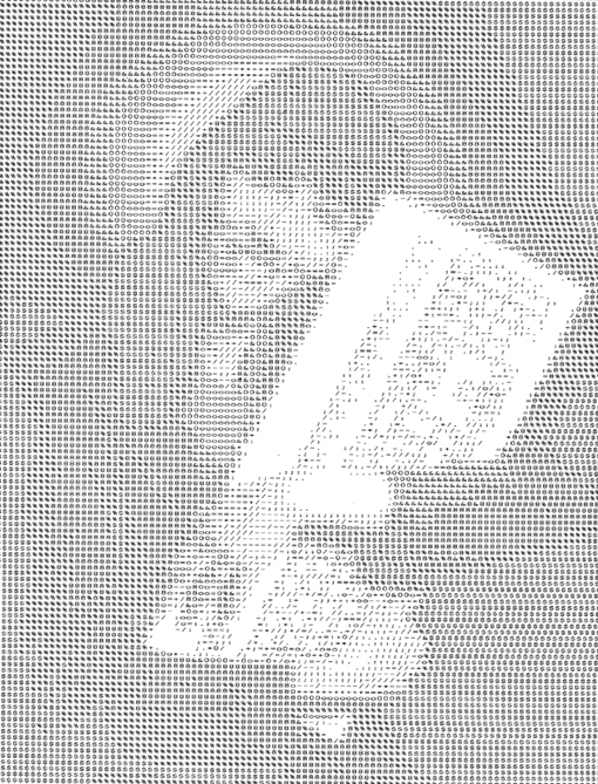
RB: Ok, maybe to concretise this question a little – what are ‘hyperstitional operators’? Are they ‘memes’? And in what terrains would their ‘future interventions’ most significantly occur for XF? Upon what terrains, exactly, is the fictive, the semiotic, the hyperstitional, actually acting for XF? Does it ever meet a ‘realpolitik’?
LC: Hyperstitional operators could be a variety of things – but at least according to CCRU definitions they are ideas that enter and transform the flow of cultural reality – a kind of hype mutated into actuality. We don’t spend much time on hyperstition because there doesn’t seem to be an adequate understanding of how this engine works exactly, but perhaps a more useful way to illustrate the power of fiction upon reality, is to look at it through the lens of modelling practices. The study on the Black-Scholes model of options pricing (arguably one of the most important models ushering in financialisation) from the sociologist Donald Mackenzie is a really interesting case wherein the model – at first – had little correlation to pricing activities on the trading floor; but as the model gained traction, won a Nobel Prize and became a tool of the trade, reality started to conform to the predictions of the model. This is a simplification of a book-length study, but the point being that the uptake, or ‘performativity’ of the model produced a reality in its likeness, provoking Mackenzie to even close his book with the question “What sort of reality do we want to see performed?” Clearly, we are not advocating for more profit-imperative modelling innovations, but we can leverage this incredible potency differently since we know how effective it can be. Models don’t represent or merely ‘reduce’ reality; they are tools as the philosopher Margaret Morrison argues, to intervene in reality.
RB: There is a sense that accelerationism and XF is invested in the organisational techno-architectures of social programmes, in platform-building and scaling networks. If so, how can one avoid the bureaucratic traps of techno-social administration – like the coercion and (self) surveillance through data management – that are encouraged under the guise of ‘creative tech innovation’? In addition, how can one escape the internal race, gender and class hierarchies that are often so constitutive to open techno-collaborative platforms?
LC: The materialisation of the conceptual framework raised in XF is certainly the largest, most difficult task at hand, one that will require substantial collaboration outside of our group. The hope with XF is that it manages to conceptually infect others to experiment on this tangible level. We know that the development of technology is also a reflection of our own biases, limitations, needs, desires and perceptions of the world, so contaminating this perceptual or cognitive level, although not enough, is still an important step. Your question really points to the delicacy and riskiness of our current world where so many potentially beneficial innovations are twisted to serve the few, be it either through sheer profit gains or through the cultural capital of becoming an antagonistic hero. The gross demographic misrepresentation within the building of techno-architecture (not to mention access to it) is the most obvious, direct hurdle to leap in order to mould and retrain these structures to serve the many. There are no user-manuals as to how to avoid the hazards you mentioned, all of which are bound to ideological imperatives of our time (for profit and self-branding), so any radical overhauling of the purposes that technology may serve, is wholly dependent on the restructuring of our given ideological ‘myths’ or frameworks.
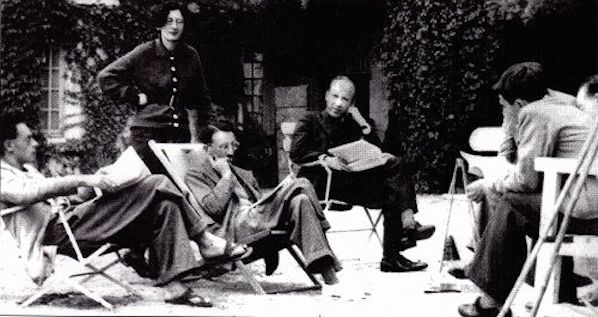
RB: Is Laboria Cuboniks intended as collective pseudonym for others to inhabit, in a similar way, for example, to Luther Blisset where a specific political tactic was applied through its availability as an open alias, or is it a more limited identification, akin to art group Bernadette Corporation which was always a specific core group of authors? How important is anonymity? Are there other groups you know of assuming the tenets of Xenofeminism as a discourse/practice? Do you envisage more Xenofeminist ‘chapters’ as a scaling strategy?
LC: Our name is an anagram of Nicolas Bourbaki, another collective pseudonym for group of largely French mathematicians from the 20th century advocating for abstraction and genericity in their field, so we playfully identify with them. As of now, the group is just the six of us, and, for the better or for the worse, anonymity was never achieved from the outset having launched the manifesto in person (without costumes and robot voices). In hindsight, the performative ‘appearance’ of Laboria could have been much more elaborately conceived and enacted – but as it is now, the importance must be placed on the labour of XF in general (open to anyone who wants to tinker, intervene, augment, refute and expand on these initial claims), and not on ‘Laboria’, the author. We’ve seen several groups and individuals respond to the manifesto – either through translation, dissemination, zine creation, talk-radio, inclusion in course readings, artistic practices and so on – and this is crucial to any ambitions of scaling up beyond our own finite capacities. Perhaps it would make sense to speak of ‘nodes and forks’ rather than ‘chapters’; ‘chapters’ seem to indicate a certain linear sequence that fulfils a narrative, whereas ‘nodes and forks’ affords a plurality of actants and events, piece by piece, deviation by deviation.

CS+ RB: Many thanks for clarifying some of our questions related to xenofeminism. The issues you address are urgent and we hope your manifesto will inspire technofeminist experiments on all scales and levels and contribute to the materialisation of more feminist concepts, particularly within the development of technology.
In the introduction of Civic Radar, editor Peter Weibel sets out the motivation, layout and journey of the book. This first comprehensive monograph of Lynn Hershman Leeson’s artistic career, spanning across five decades. It must have been a dizzying publication to work on, when compiling her pioneering work in the fields of photography, video, film, performance, installation, and interactive and net-based media art. It is noteworthy that Hershman Leeson collaborated in its production. One feels her personal involvement in the book – its richness, care and detail, shows in its nearly 400 pages, and approximately 500 illustrations. It also features supporting texts by other writers, curators, theorists, and artists, such as: Andreas Beitin, Pamela Lee, Peggy Phelan, Ruby Rich, Jeffrey Schnapp, Kyle Stephan, Kristine Stiles, Tilda Swinton, Peter Weibel and interview by Hou Hanru and Laura Poitras with the artist.
“I try to live in the present, because most people live in the past. If you live in the present, most people think you live in the future, because they don’t know what happens in their own time.” Lynn Hershman Leeson.
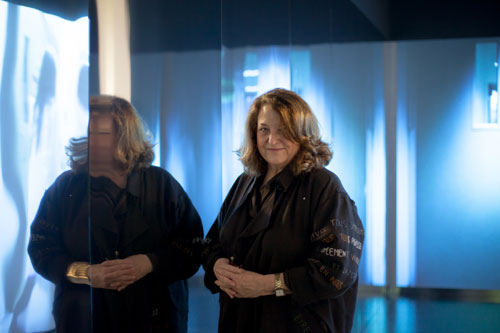
Lynn Hershman Leeson has pioneered uses of new technologies, recognized as key to the workings of our society today. She tackles the big questions surrounding: identity in a time of mass, overpowering consumerism; privacy in an era of surveillance; the interfacing of humans and machines; the relationship between real and virtual worlds; and new bio-ethics surrounding practices such as growing parts of the human body from DNA samples. We can think of Hershman Leeson as a direct artistic descendant of Mary Shelley. Consider Shelley’s celebrated publication, Frankenstein: Prometheus Unbound, published in 1818, and its challenges towards macho revolutionaries of ‘reason’, and her critique of the misuses of science and technology by the patriarch. We can see strong parallels between both women. They are feminists, who have managed to find ways around (and to work with) traditional forms of dominant, patriarchal frameworks, so to express personal, creative and cultural identities, on their own terms.
“Lynn Hershman Leeson’s mission statement seems to be that the body is a programmable software embedded in a changeable hardware. Therefore, she shows us so many hybrids and mutants, aliens and agents, actors and avatars, in real life and second life. From Dolls to clones, she demonstrates the paradox plurality of identities especially in the age of total observation.” [1] (Weibel 2016)
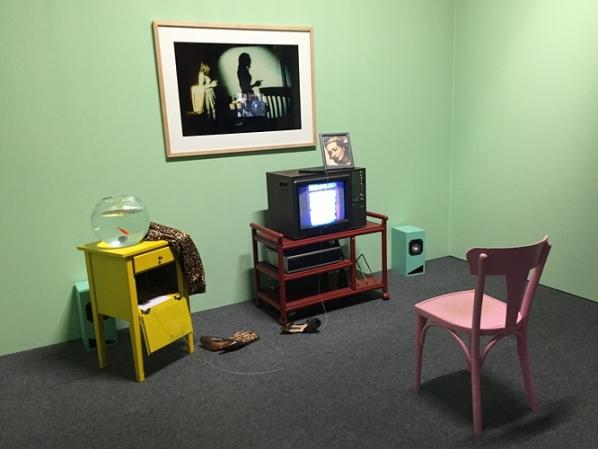
Hershman Leeson’s artistic process however does not keep its distance from the processes of science and technology. She leaps into the depths of our fears and unreservedly engulfs herself, and her imagination in their material influences and modifications. Like Donna Haraway, Hershman Leeson takes cyborgs, misfits, biology, mutation and transformation as her inspiration, contexts and materials. And also like Haraway, she playfully and critically owns concerns around science and technology, along with the ethical issues that may arise out of their continuously shifting, influences on society; and, thus not owned by or weighed down by them. Every work put forward by Hershman Leeson, is an experiment. Her interests and knowledge inspired by science and technology reflects her constant state of contemporariness. Her work directly correlates to breaking down systems of perceived values.
“Hershman Leeson confronted conventional gender roles and exposed the normative construction of gender identity. Some of her videos have included cross-dressers and transgender men and women, as in Double Cross Click Click (1995), and her assumed male pseudonyms at a time when the art world was dominated by men who mostly ignored women.” [2] (Beitin 2016)
Hershman Leeson’s art moves fluidly between different formats, contexts and disciplines. This of course is not easy to brand. The art market survives by promoting art that fits into particular roles and products that are easy to promote, predict and consume. The irony here is that the art world promotes the idea of itself as a site of novelty and insights, but in reality represents a deeply conservative culture. Some artists, Hershman Leeson is one of them, transcend the contemporary artworld norm and build alternative universes, contexts and identities, where the art is so investigatory and esoteric, traditional conventions are challenged.
When I interviewed Hershman Leeson last year for Furtherfield she talked about how she’d like to “eradicate censorship, and make more transparent the capitalistic underpinnings that are polluting access, value and visibility”. In the 70’s, she was the first artist working on a prison art project in San Quentin, and many of her early public art works “geared toward social change.” [3]
Civic Radar shows us that her work is not reduced to a singular, reflection of her own creative self. There is a wider story and it includes the voices of many others as part of the narrative of her life and her work, as well as reclaiming a history in a male dominated society.
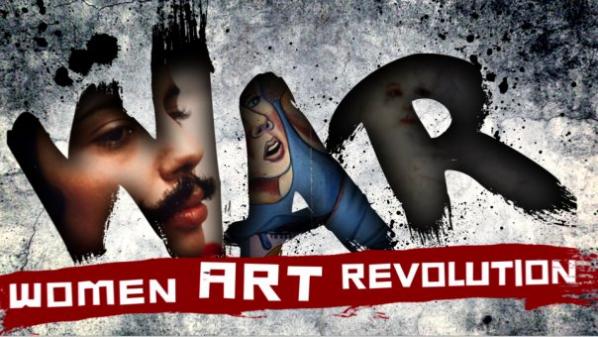
We see reaffirmed a varied and dynamic history where she has been involved in strengthening the role of women in society, as part of an extension of her art process. One excellent example of this rich history is that over a period of 40 years she interviewed an extensive array of women artists, historians, activists, and critics who integrated personal and political content into their work. Then, some of that gathered material was made into a film project !Women Art Revolution, in 2010.
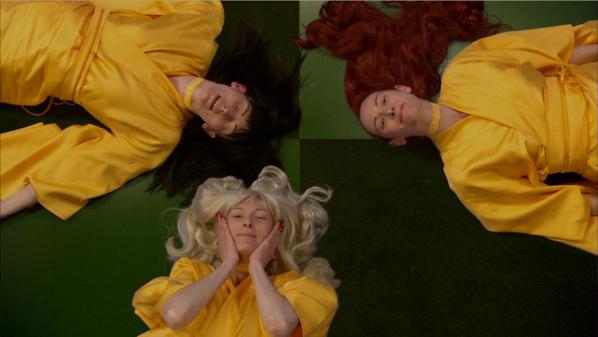
Lynn Hershman Leeson has not only achieved pioneering work as an artist, but also as filmmaker. She has collaborated with actor and Oscar winner Tilda Swinton in several feature films that have gone on to receive numerous awards at international film festivals on account of their outstanding quality and innovative themes. »Teknolust« is an absurd, amusing and scientifically highly topical science-fiction drama on the subjects of cyber-identities, biogenetics, gender constructions and sexual self-determination in the age of the Internet. The plot turns on the scientist Rosetta Stone (Tilda Swinton), who illegally produces three clones of herself. The artificial entities can only be distinguished by the color of their clothing and live in an enclosed cyberspace. Because they are dependent for survival on the male Y chromosome, Ruby, the femme fatale among the clones, goes in regular pursuit of men. Sexual contact with Ruby leads to impotence in her lovers as well as to an allergic reaction triggered by a computer virus which is transferable to human beings. The FBI becomes aware of the clone family’s machinations following the increased incidents of infection among men, and begins to investigate. Note*
Her work has crossed into many different fields and formats. Which includes: installations, videos, films, sculptures, robots, avatars, contracts, computer programs, photography, paintings, drawings, collages, browser based art, artificial intelligence, bio-matter, network communication systems and devices. Synthia Stock Ticker and Dollie Clones are just two examples that demonstrate how ahead she has been with her ideas and her integration of digital technologies into art. Synthia Stock Ticker, is a networked-based media artwork made in 2000. It refers to the stock ticker invented by Thomas Edison and is unusually prescient in its portrayal of the emotional life of global markets. Inside a glass casing sits a small monitor screen, showing a video of a woman character named Synthia. “When the market is up, the character dances and shops at Christian Dior: when the market is down, she chain smokes, has nightmares, and shops at Goodwill.” [4]

Again The Dollie Clones 1995-96 predate a contemporary artistic obsession with creeping surveillance. Two telerobotic dolls, Tillie the Telerobotic Doll and CyberRoberta, whose eyes have been replaced with cameras. Each doll has a website that allows users to view the images taken by the webcams and click on an “eyecon” to telerobotically turn the doll’s head 180 degrees to survey the gallery.

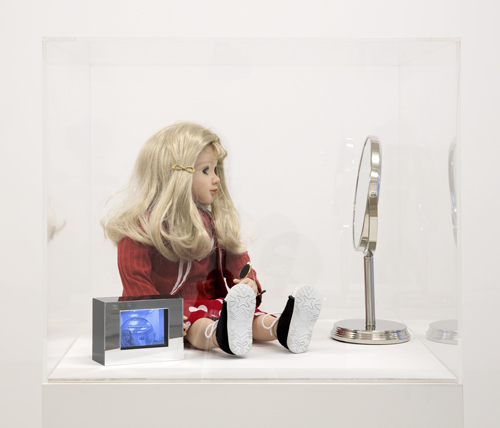
Hershman Leeson’s most prominent performance work was as another woman, Roberta Breitmore. This elaborate alter ego existed between 1973 and 1978. The Breitmore character was well developed, possessing different behaviors and attitudes to Hershman Leeson’s own personal identity. Roberta Breitmore had her own handwriting, clothing, wig, makeup, driver’s license, apartment, psychologist, bank account, credit cards, acquaintances, life story, and adventures. Hershman Leeson took the audacious leap and sporadically became Roberta Breitmore for 5 years. Other women also lived as Roberta Breitmore and sometimes simultaneously. [5]

“Hershman Leeson hired three additional performers, all women, to play Roberta. They wore costumes identical to the ones Hershman Leeson herself wore, and they treated Roberta essentially as a professional (albeit part-time) gig. They undertook some of Roberta Breitmore’s correspondence and went on some of her dates (which were documented in photos and audio recordings). Eventually, Hershman Leeson stopped enacting Breitmore, reducing the instantiations of Roberta Breitmore from 4 to 3.” [6] (LaFarge 2007)
The spirit of Hershman Leeson’s radical art persona can be seen in younger, contemporary artists today. For instance, Heath Bunting’s Identity Kits, part of his larger The Status Project consist of various items, personal business cards, library cards, a national railcard, T-Mobile top-up card, national lottery card and much more. “They take a few months to compile each of them because they are actual items that everybody uses in their everyday lives, involving evidence of identity. There is also a charge for the package of 500.00 GBP, which is cheap for a new identity.” [7] (Garrett 2014) Then we have Karen Blissett, an Internet artist who suddenly decided to go multiple by opening up all of her email, Twitter, Facebook and Google accounts to many different women around the world. “A torrent of provocative, poetic, and often contradictory voices issued proclamations, made auto portraits, and shared psalm-like meditations on her existential transformation; distributed across online platforms and social spaces, in text, image and video.” [8] (Catlow 2014)
Towards the end of Civic Radar a collection of pages show us various images of the exhibition by the same name at the ZKM Museum of Contemporary Art, in Germany 2014. When viewing the images of her work in the large gallery spaces you realize the scale of it all, and how substantial her work is.
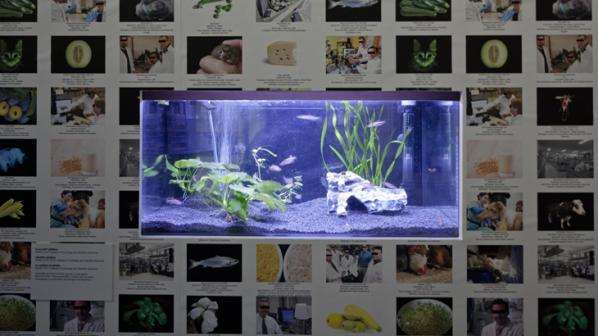
Moving on after the images of the works in ZKM, there is a selection of Hershman Leeson’s texts written, from 1984 and 2014. These writings, take us through different stages of her career, revealing ideas and intentions behind much of her work and also some of the work included in the publication. In the last paragraph of the last text in a short essay, titled The Terror of Immortality she writes about the contexts that have given rise to her most recent work. “As organic printing and DNA manipulation reshapes the identities of newly manipulated organisms, so too the culture of absorbed surveillance has dynamically shifted. In the next 100 years, the materials used to create DNA will become increasingly distributed and hybridized. The implications of this research include not only the creation of a sustainable planet of hybrid life forms that can survive a sixth extinction and incorporate into to its existence a morally responsible future.” (Leeson 2016)
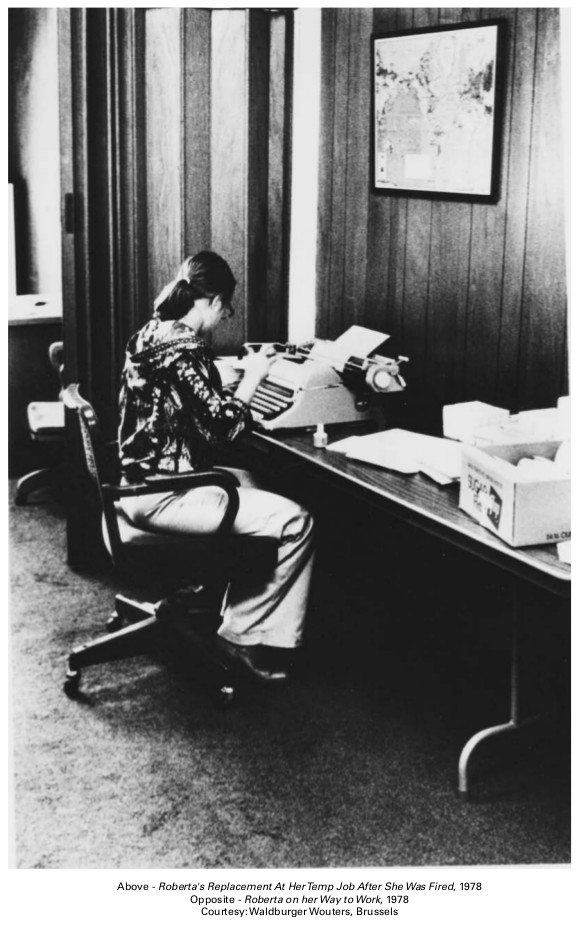
This book is a profound read, offering an insight to this generous and profound artists’ fantastical journey in an era marked by accelerating change. And what’s so amazing is that the content, the narratives, and the histories, are real. It is an Aladdin’s Cave of rich, exceptional artworks, flowing with brilliant ideas. Hershman Leeson has had her finger right on the pulse of what’s relevant in the world for a long time, and transmuted the knowledge she unearths in her examination of identity, feminism, science, technology and more into her own artistic language.
Her work is way ahead of most contemporary artists showing now. This book should be read everywhere. Not just because it features great art, but also because features a woman with a great mind. I am not a fan of the words genius or masterpiece; I find them tiresome terms reflecting a form of male domination over women and the non-privileged classes. Yet, after spending time with Civic Radar, I cannot help myself thinking that I have just witnessed something equivalent without the negative baggage attached.
*Text from ZKM – Teknolust. With Lynn Hershman Leeson at the cinema.
http://zkm.de/en/event/2015/03/teknolust-with-lynn-hershman-leeson-at-the-cinema
In 2015, ZKM in cooperation with the Deichtorhallen Hamburg / Sammlung Falckenberg exhibited the first comprehensive retrospective of Leeson’s work, including her most recent productions of art. Last year Modern Art Oxford hosted a major solo exhibition of her work Origins of a Species, Part 2 and she also has work in The Electronic Superhighway, at Whitechapel Gallery, in London.
Body Drift: Butler, Hayles, Haraway (Posthumanities)
Author Arthur Kroker. University of Minnesota Press (22 Oct. 2012).
Body Drift by Arthur Kroker, takes the work of three leading women thinkers as its main focus. It therefore would feel strange, before venturing on to the review, not to mention Marilouise Kroker, his wife and collaborator who he credits with shaping the critical direction of his thought “on bodies and power.” [1] Together Marilouise and Arthur Kroker have created an abundance of work in the fields of technology and contemporary culture. They both edit the peer publishing electronic journal CTheory founded in 1996. They co-authored the influential Hacking the Future (1996), and Marilouise Kroker has co-edited and introduced numerous anthologies including Digital Delirium (1997), Body Invaders (1987), and Last Sex (1993) and Critical Digital Studies: A Reader. Marilouise Kroker is Senior Research Scholar at the University of Victoria. A recent bio written about them says “Arthur and Marilouise Kroker are the hipsters of Canadian media theory.” [2]
Arthur Kroker is Canada Research Chair in Technology, Culture and Theory, Professor of Political Science, and the Director of the Pacific Centre for Technology and Culture (PACTAC) at the University of Victoria. His recent publications include The Will to Technology and the Culture of Nihilism: Heidegger, Nietzsche, and Marx (University of Toronto Press) and Born Again Ideology: Religion, Technology and Terrorism. Dr. Kroker’s current research focuses on the new area of critical digital studies and the politics of the body in contemporary techno-culture. http://web.uvic.ca/~akroker/
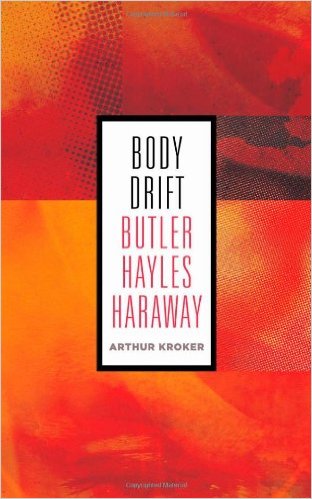
This review is written three years after the publication of the book but it feels even more relevant now than ever for reasons that will, I hope become plain…
Body Drift focuses on three major feminist theorists, Judith Butler, Katherine Hayles and Donna Haraway. They have had a deep influence on my own work and of course on media art culture through the years. They have profoundly altered our views on technology, feminism, queer theory, postmodernism, marxism, hacking, hacktivism, cybernetics, the Internet, network culture, politics and posthumaniism. Re-examining their critical perspectives and creative processes – assemblages, remixing and cyborgs- Kroker terms the emerging technological spectre body drift. He examines the connections between what he sees as Judith Butler’s postmodernism, Katherine Hayles’s posthumanism, and Donna Haraway’s companionism.
Through the spectrum of Body Drift he attempts to find a clearer understanding of the contemporary material body and its societal complexities. He views two opposing forces at work in body drift. One is, the continual disappearance of human things and values, alongside excluded ethnicities and outlawed sexualities. He connects this with an entrapment by social crisis in which actual democratic aspiration is dwindling. In parallel to this mass loss of our freedoms other factors are at work. He sees it as overall, and an eventual series and states of resistances. These are evolutionary forms of hybridity and as such are key paths for what he argues is the function of our posthuman condition. [3]
There are numerous techno-visions expounding how technology will change our lives and futures. What for me, separates a classic posthumanist and a critically aware posthumanist is that the latter is not only aware of the necessity of grass roots culture and inclusion of female voices, but is also critical of domination over others as key when engaging in the processes of innovation. Thus moving beyond existing frameworks that perpetuate patriarchal language, methods of centralization and colonial habits.
In his book You Are Not A Gadget: A Manifesto, Jaron Lanier described Ray Kurzweil’s excitement about The Singularity as apocalyptic. Lanier says “The coming Singularity is a popular belief in the society of technologists. Singularity books are as common in a computer science department as Rapture images are in an evangelical bookstore.” [4] Kurzweil’s digestible techno-bites fit well alongside big business and with Peter Diamandis a wealthy entrepreneur. Dr. Peter H. Diamandis and Dr. Ray Kurzweil co-founded the Singularity University. In To Save Everything, Click Here: Technology, Solutionism, and the Urge to Fix Problems that Don’t Exist, Evgeny Morozov writes that Diamandis “promises us a world of abundance that will essentially require no sacrifice from anyone – and since no one’s interests will be hurt, politics itself will be unnecessary.” [5]

In The Joy of Revolution Ken Knabb wrote, “Marx considered it presumptuous to attempt to predict how people would live in a liberated society. “It will be up to those people to decide if, when and what they want to do about it, and what means to employ.”” [6] Kroker says, “In my estimation, while Marx, Nietzsche and Heidegger may have provided premonitory signs of the charred landscape of the technological blast, it is the specific contribution of Butler, Hayles and Haraway to provide a deeply compelling account of the fate of the body in contemporary society.” [7] This includes how we evolve our Internet freedoms, surveillance, and cyber attacks in a post-Snowden world. While we’re, either reshaping or being reshaped through the constant production of new technologies and political re-invention, it is crucial that there exists regular critique reflecting on these influences and changes on people, animals, society, the planet, and the universe. Thankfully, Butler, Hayles and Haraway disrupt the normalization and dangerously hegemonic acceptance of ‘the male overlord and his machine’ over the rest of us.
How our bodies and the idea of our bodies relate to this complex world is Kroker’s primary interest. In the introduction Kroker says that we no longer inhabit a body in any meaningful sense of the term but rather occupy a multiplicity of bodies – imaginary, sexualized, disciplined, gendered, laboring technologically augmented bodies. [8] Hayles has not only bridged the gap between science and literature, but also media art. In 2000, Hayles wrote an insightful piece on Patchwork Girl, an artwork made by Shelley Jackson in 1995, a hypertext fiction and remix of Mary Shelley’s Frankenstein. When discussing Jackson’s piece Hayles said, “As the unified subject is thus broken apart and reassembled as a multiplicity, the work also highlights the technologies that make the textual body itself a multiplicity.” [9]

Kroker says, “”Like Heidegger before her, Hayles refuses to privilege either interpretation to the exclusion of its opposite, preferring a form of thought similar to “pendurance,” that moment when, in the folded twists of complexity theory, “one comes over the other, one arrives in the other.”” [10] In an interview with Josephine Bosma on the Nettime email list, in Nov 1998, Hayles said “There may be other ways to think about the subject that don’t find themselves first and foremost on this notion of ownership. New technologies open up possibilities for rethinking other ways to begin to construct the subject.” [11] Krokers sees Hayles as providing us with the digital alphabet to explore the complexity and connections of technopoesis. “To read Hayles is, in fact, to begin to experience the fractures, bifurcations, and liminality that stretches across the skin of posthuman culture.” [12]
Donna Haraway in her introduction to A Cyborg Manifesto: Science, Technology, and Socialist-Feminism in the Late Twentieth Century, in 1985 she said, “Though both are bound in the spiral dance. I would rather be a cyborg than a goddess.” This unsettled many feminists at the time. Haraway was not interested in reclaiming what she saw as a lost ideal based on matriarchal values. Instead, she wanted women to re-invent and create their own versions of what a female could be or not be, by playfully exploiting the cyborg myth and concept in the here and now. [13] This reconstruction of the woman, Kroker says, poses particular twists and knots, and contradictions. He emphasises that we’re not discussing a traditional form of feminism but a hybrid vision of feminism. [14]
“Not waiting passively for the capricious experience of biotechnology to produce spliced bodies, Haraway has made of her own mind a biopolitics on creative hyperdrive. Deeply immersed in the (bio)scientific disciplines, always distancing herself from seductions of technological representationality by feminist difference, continuously provoking boundary breakdowns in her own thought by refusing to assent to an anthropomorphic species-heirarchy, Haraway is a theorist of the splice.” [15] Kroker (2012)
Kroker moves on from Haraway’s concepts on the cyborg to her later inter-species theory. He tries to untangle the complexity of her personal, political and theoretical relations in respect to where her critical strength is best engaged. He’s drawn to what he sees as ““Haraway’s profound conceptualization of “companion species.”” Haraway challenges the established role and hierarchical control by us humans over animals, plants, objects, and humans. [16] In her publication The Companion Manifesto: Dogs, People, And Significant Otherness, Haraway says, “I believe that all ethical relating, within or between species, is knit from the silk-strong thread of ongoing alertness to otherness-in-relation.” [17]
Haraway’s text in The Companion Manifesto conveys a shocking sense of freedom as if written by someone who longer gives a damn about her academic reputation. Perhaps, what I mean here is that the thinking reaches further than academia and builds alliances with others who may not have read her other works. In the chapter A Category of One’s own, Haraway says, “Anyone who has done historical research knows that the undocumented often have more to say about how the world is put together than do the well pedigreed.” [18] As with her concept for Situated knowledges her intention is to connect beyond officially accepted canons and norms, and established hegemonies. In his chapter HYBRIDITIES Kroker says “Haraway’s writings reveal the apocalypse that is possibly the end condition of hundreds of years of (Western) scientific experimentalism.” [19] This does not mean the West is doomed. However, Haraway has always been on the side of otherness, whether for humans or nonhuman entities. In her eyes our futures or the world as it actually is may not necessarily be as reliant on technology as we like to think.
“Perhaps most importantly, we must recognise that ethics requires us to risk ourselves precisely at moments of unknowingness, when what forms us diverges from what lies before us, when our willingness to become undone in relation to others constitutes our chance of becoming human.” [20] Judith Butler.
Of this quote from Butler’s Giving an Account of Oneself, 2005 [21], which opens the second chapter in Body Drift, Kroker says, “Could there be any text more appropriate to both understanding and perhaps, if the winds of fate are favorable, transforming contemporary politics than Judith Butler’s eloquent study of moral philosophy..?” [21] In Giving an Account of Oneself, Butler presents us with an outline for a different type of ethical practice and proposes that, before you even ask what ought I to do? Ask yourself the question who is this ‘I’? Butler, proposes that it is “a matter of necessity” that every person should “become a social theorist.” [22] Indeed, in the City Lights interview with Peter Maravelis, Kroker says Butler is speaking in terms of people breaking their silence, such as “the repetition chorus of OCCUPY during the Wall Street insurrection”. [23] And then he says, “In many ways, all of Butler’s thought is “standing as witness.” [24] Butler stands witness to what we now know in the 21st century as a violent regime of heterosexual masculinity spreading its domination over history, technology and life itself.
Butler, Hayles and Haraway are major players in feminist and queer academia and media art culture. They have all been active in breaking away from the traditional behaviours that have kept us caught within loops in various ways. Their fluid and progressive approaches to feminism are not only of value to women alone but it can also help others think beyond restrictive behaviours. Kroker’s book manages to reflect the fluidity of networked and contemporary aspects of body drift well, especially from a critically aware, posthumanist perspective. However, no matter how you slice it, it’s about personal and collective freedoms, how we can somehow reclaim our states of being, and how we can own our subjectivities and our psyches in whatever forms these may take. As artists, as humans and or as posthumans – we need Butler, Hayles and Haraway to guide us through this ever-changing, twisting, everyday, posthuman terrain.
“None but those who have experienced them can conceive of the enticements of science.” Mary Shelley, Frankenstein.
Rachel Falconer writes about the cyberfeminist art collective subRosa, a group using science, technology, and social activism to explore and critique the political traction of information and bio technologies on women’s bodies, lives and work.
Following a recent interview with the founding members of the collective, Hyla Willis and Faith Wilding, this article presents subRosa’s trans-disciplinary, performative practice and questions what it means to claim a feminist position in the mutating economies of biotechnology and techno-science.

The technological redesigning and reconfiguration of bodies and environments, enacted through the economies of the biotech industry, is an emerging feature of contemporary life. As these new ‘bits of life’ enter the biotech network, there is a slippage in our mental model of what constitutes the body, and more specifically, ‘life’ itself. As radically new biological entities are generated through the processes of molecular genetic engineering, stem cell cultivation, cloning, and transgenics, bio-artists and bio-hackers co-opt the laboratory as a site of critical cultural practice and knowledge exchange. Human embryos, trans-species and plants are constructed, commodified, and distributed across the biotech industry, forming the raw materials for bio-art, DIY biologists and open science culture.[1] These corporeal products and practices exist within new and alien categories, transgressing the physical and cognitive boundaries set by biopunk science fiction and edging towards the possibility of a destiny driven by genetics and life sciences. With the eternal rhetoric of a high-tech humanity, and the threat of Michel Foucault’s[2] biopolitics constantly on the horizon, today Harraway’s[3] myth of the cyborg exists in the form of corporeal commodities travelling through the global biotech industry. Scientific research centres stock, farm, and redistribute biological resources, (often harvested from the female scientists themselves). Cells, seeds, sperm, eggs, organs and tissues float on the biotech market like pork belly and gold. Seeds are patented, and other agro-industrial elements are remediated and distributed as bits of operational data across the biotech network. We/cyborgs[4], are manifested as a set of technologies and scientific protocols, and, as a result, the female body in particular, is reconfigured into a global mash-up of cultural, political and ethical codes.
The increasingly pragmatic realisation of the biotech revolution has provoked a ‘cultural turn’ in science and technology studies in general, and feminist science studies in particular. Carolyn Christov-Bakargiev’s dOCUMENTA (13) proposed an interdisciplinary approach to the role of science for ‘culture at large’. Certainly, by foregrounding the heavy hitters in the field such as Donna Haraway and Vandana Shiva, dOCUMENTA (13) laid claim to addressing the global conflicts of biotechnology. However, the feminist agenda was not specifically addressed, and the key issues of the impact of biotechnologies on feminist subjectivities were only paid minimal lip service. With the exception of Shiva[5], the tone of dOCUMENTA (13) hinted at a positivist, emancipatory take on biotechnology and technoscience without assuming a critical position. There was very little public debate or critical analysis engaging the philosophical, ethical, and political issues of feminism and female subjectivities within the realm of biotechnology.
Notably absent from last year’s dOCUMENTA (13), the activist feminist collective subRosa’s performative, interdisciplinary projects are channelled towards embodying feminist content, practices, and agency, and laying bare the impact of new technologies on women’s sexuality and subjectivities – with a particular emphasis on the conditions of production and reproduction. Through their research-led practice and pedagogical mission, the collective analyse the implications and conditions of the constantly surveyed female body, whilst mapping new possibilities for feminist praxis. subRosa interrogate the conditions of surveillance, private property rights, and other control mechanisms the female body is subjected to by ART(Assisted Reproductive Technologies). The collective’s hybrid, interdisciplinary practice navigates the multiple identities the female body has taken on through techno-scientific development, including: the distributed body, the socially networked body, the cyborg body, the medical body, the citizen body, the soldier body and the gestating body. In contrast to the overarching and pervasive illustration of the technoscientific cultural landscape painted by dOCUMENTA(13), the current members and founders of the collective, Hyla Willis and Faith Wilding, are very clear in their critical intent. The collective choreograph and place themselves within globalized bio-scenarios in order to question the potential for resistance and activism within these constructs.
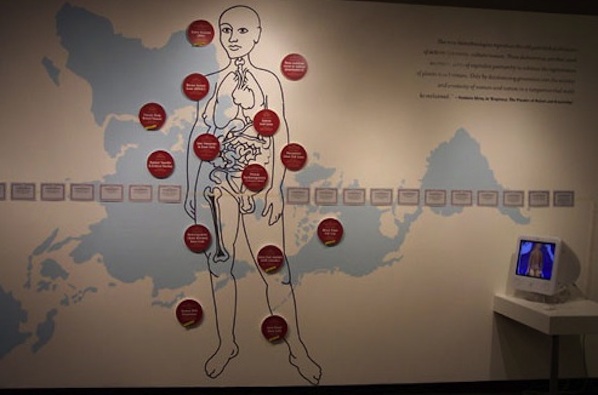
subRosa’s overarching vision to create discursive frameworks where feminist interdisciplinary conversations and experiments can take place, is research-led and takes its cue from the canon of radical feminist art practices. Cell Track: Mapping the Appropriation of Life Materials has featured in a number of exhibitions, most recently in Soft Power. Art and Technologies in the Biopolitical Age, Vitoria-Gasteiz, Spain. This project consists of an installation and website examining the privatization and patenting of human, animal and plant genomes in the context of the history of eugenics. Cell Track highlights the disparity between the bodies that produce stem cells and the corporations that control the products generated from them. Bringing together scientists, cultural practitioners and wider publics in the construct of the gallery space, subRosa generate discourse around the patenting and licensing of DNA sequences, engineered genes, stem cell lines and transgenic organisms. The project’s participatory aim is to set up an activist, feminist embryonic stem cell research lab in order to produce non-patented stem cell lines for distribution to citizen scientists, artists and independent biotechnologists. This environment of shared knowledge production and speculative, alternative, research activity is at the heart of subRosa’s social practice.

Due to the pedagogical nature of subRosa’s activities, the collective’s critical stance towards IVF and ART has proven to be particularly provocative, and their scepticism towards the emancipatory language of ‘choice’ co-opted by ART, has been met with some resistance by other feminist practitioners. However, it is in this very agonism[6] that subRosa wish to become more visible, and they welcome criticism and debate in the public discursive spaces that they create. In a recent interview, Faith Wilding and Hyla Willis both expressed their desire to generate an expanded, and deeper discussion about the wider issues involved in ART in particular and biotechnology’s effect on female identity in general. subRosa’s potential to reach wider publics and audiences is partially determined by the socio-political context of the communities in which they operate. Perhaps in reaction to this, subRosa’s focus is now shifting towards embracing the aforementioned ‘cultural turn’ in science as they address the position of feminist scientists themselves.
The imperative to reclaim feminist discourses and narratives in science is of growing concern to subRosa, as they believe that feminist agency lies in the practice of science itself. By relocating lab-work from the dominant scientific institutions to the public environment of the gallery, subRosa provide the critical space in which new feminist scientific praxis can operate,[7] and new dialogues and discourses can be created. Their conviction that political and critical traction lies in practice as discourse, and the potential of face to face encounters, is demonstrated in their recent project for the Pittsburgh Bienal: Feminist Matter(s): Propositions and Undoings (2011). In this installation, SubRosa take Virginia Woolf’s[8] assertion that ‘tea-table thinking’ provides an effective antidote to the male-driven ‘war-mentality brewed in boardrooms and command centers’ as their main conceit. Redeploying Woolf’s idea toward the rethinking of the traditionally male-dominated discipline of science, Wilding and Willis’ installation brings traces of the science laboratory to the intimacy and hospitality of the kitchen table, and in turn, also situates what is normally a private, feminized space in a more public domain.
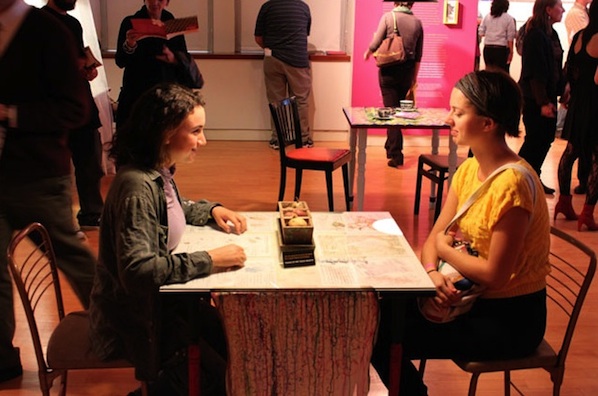
These tables stage a dialogue between one or two visitors in response to the presentation of female figures in science, both the popularly acknowledged and the underexposed. subRosa foreground women scientists past and present and reimagine an alternative, feminized history of science and technology. The installation explores feminism and participatory practices as modes of scientific research, with the aim of generating dialogue and discourse around the questioning of the dominant historical narrative of science. Specially tailored installations reside on each table, evoking lab work while celebrating the history of the women protagonists they play host to – from anarchist painter Remedios Varo to geneticist Barbara McClintock.

subRosa’s pedagogical imperative is at once inclusive and provocative, and their role as facilitators of a discursive space outside the traditional institutions and control structures of science, is where their radical aspirations lie. Pedagogical art practices often teeter on the brink of propaganda, and subRosa are quite comfortable with the propagandistic label. Considering the economic and cultural climate in the USA with regard to the politics of reproduction, their work has been particularly well received in the context of European cultural institutions, whereas in the USA there is greater interest for the work in academic institutional settings. Perhaps this could be symptomatic of the general privileging of discourses around intersex, transgender and queer subjectivities. The dominant bias of the gatekeepers of the artworld to showcase queer practices is evident in the promotion of artists such as Ryan Trecartin and Carlos Motta on the international circuit. Curators have tended to position artists addressing the gendered ‘Other’ within a contemporary queer framework, whilst keeping feminist art practices on the peripheries of 1960s/1970s retrospective nostalgia. This tendency presents a muddying of the waters for contemporary feminist art practices such as subRosa.
This may also be part of a more general tendency to demonize and move away from feminist identities and discourses in wider society. The academic shape shifting from ‘women’s studies’ to ‘gender studies’ to ‘queer studies’ has diminished the feminist conversation and, therefore, the impact and receivership of feminist art practices. This has rendered the popular conception of ‘Queer’ as acceptable and non-aggressive. Furthermore, the term ‘Queer’ and the subsequent morphing into the verb ‘queering’, has been co-opted by transdisciplinary academic discourse, and is now an expansive, all embracing cultural term – a phenomenon that has met with a certain amount of scepticism from the queer community.
This privileging of the expansive ‘othering’ of queer rhetoric has often resulted in feminism being rejected as a radical and out-dated political identity by art practitioners themselves. This ambivalent attitude is perhaps also indicative of the wider feminist debate, in which post-feminism has splintered into fragmented, diluted groups, each policing their own identity politics with little sense of a bigger struggle. However, the collaborative, interdisciplinary environments orchestrated by subRosa signal a return to the indisputably material actuality of the female body. Through their insistence on the possibilities of feminist bench-side practices, and the forensic unpicking of the power/control structures inherent in biotechnology, subRosa expands the feminist lexicon through the empirically re-appropriated organic materiality of the body.
Opening Event: Seeds Underground Party – Sat 31 August, 2-5pm
Contact: info@furtherfield.org
Visiting Information
ABOUT THE EXHIBITION
ABOUT THE ARTWORKS
ABOUT THE ARTISTS
EVENT: SEEDS UNDERGROUND PARTY
TALK: SHU LEA CHEANG – ART, QUEER TECHNOLOGIES AND SOCIAL INTERFERENCE
LOCATION
SEE IMAGES FROM THE PRIVATE VIEW
WATCH VIDEO OF THE OPENING
This exhibition by Mark Amerika (US) and Shu Lea Cheang (US/FR) at Furtherfield Gallery marks a significant moment for contemporary art. Amerika and Cheang are both ‘net native’ artists. They share many of the obsessions of the growing multitude of artists who have grown up with the net since the early 1990s.
They are also big “names” – internationally established artists who regularly show their work, to critical acclaim, at contemporary art galleries around the world. They have crossed over into the mainstream art world whilst maintaining a critical edge.
Amerika is a media artist, novelist, and theorist of Internet and remix culture, named a “Time Magazine 100 Innovator” in their continuing series of features on the most influential artists, scientists, entertainers and philosophers into the 21st Century.
Cheang is a multimedia artist who works with net-based installation, social interface and film production. She has been a member of the Paper Tiger Television collective since 1981 and BRANDON, a project exploring issues of gender fusion and techno-body, was an early web-based artwork commissioned by the Guggenheim Museum (NY) in 1998.
Both artists continue to shape and be shaped by contemporary networked media art cultures of remix, glitch, social and environmental encounters.
Shu Lea Cheang and Mark Amerika at Furtherfield Gallery provides a physical interface in a local setting in the heart of a North London park to the thriving, international, networked art scene.
The exhibition features Cheang’s UKI viral love installation and Composting the Net. These are shown alongside pieces from The Museum of Glitch Aesthetics (MOGA), Amerika’s latest work in his collaborative series of transmedia narratives.
The exhibition features large stills from two performance installations. UKI viral love is the sequel to Cheang’s acclaimed cyberpunk movie I.K.U. (premiered at Sundance Film Festival, 2000) conceived in two parts – a viral performance and a viral game. The story is about coders dispatched by the Internet porn enterprise, GENOM Corp, to collect human orgasm data for mobile phone plug-ins and consumption. In a post-net crash era they become data deprived and these coders are suddenly dumped into an e-trashscape environment where coders, twitters, networkers are forced to scavenge from techno-waste.
![UKI – Trash Mistress [Radíe Manssour] (2009) by Shu Lea Cheang – Photo by Rocio Campana](http://www.furtherfield.org/wp-content/uploads/2013/05/radie.jpg)
In 2009, Cheang moved into the art studio at Barcelona’s Hangar medialab with 4 tons of E-trash, collected in Barcelona’s city recycling plant in one day. Amidst the rubble of wires, cables, boards, keyboards and computers, along with the coders and the hackers, UKI the defunct replicants are part of the e-trashscape seeking parts and codes to resurrect themselves.
UKI viral love is developed with collaborations and residencies at HangarBCN [artistas residentes] (Barcelona, Spain), Medialab Prado [Playlab] & [Desvisulizar] (Madrid, Spain) and, LABoral Centro de Arte y Creación Industrial [Plataforma Cero] (Gijón, Spain). The work presented at Furtherfield Gallery is the first physical installation of UKI in a gallery setting.
Composting the Net sources Internet net cultures’ accumulated data. It appropriates open (un)moderated mailing list communities, used for collaboration, sharing information and dialogue, and reprocesses the information into a virtual compost. For this exhibition Cheang composts the Spectre mailing list, a channel for practical information and exchange for media art and culture in “Deep Europe”, initiated in August 2001. The abundant info-data is reused and given extra life – an artistic legacy beyond its original purpose. It is also a celebration of the independent spirit of net culture that exists outside of corporate dominated Web 2.0 platforms such as Facebook.
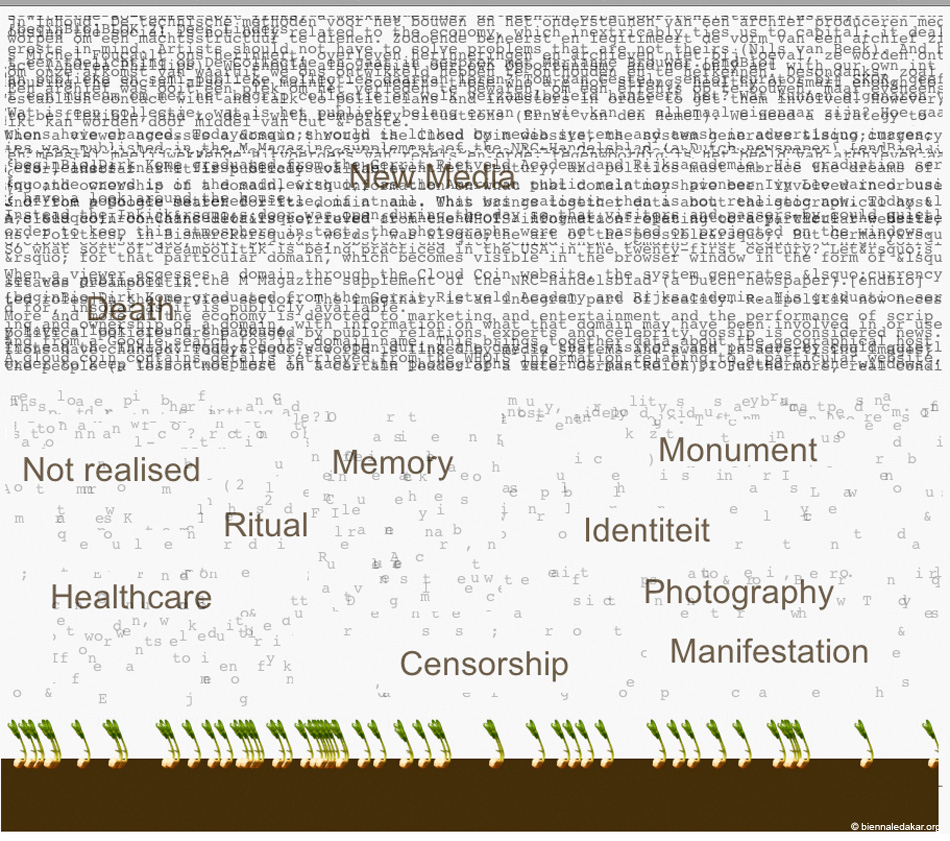
Amerika’s The Museum of Glitch Aesthetics (MOGA) features the work of The Artist 2.0, an online persona whose personal mythology and body of digital artworks are rapidly being canonized into the annals of art history. The narrative traces the life of the artist and his ongoing commitment to a practice of ‘glitch aesthetics’. MOGA features a wide array of artworks intentionally corrupted by technological processes, including net art, digital video art, digitally manipulated still images, game design, stand-up comedy, sound art, and electronic literature.
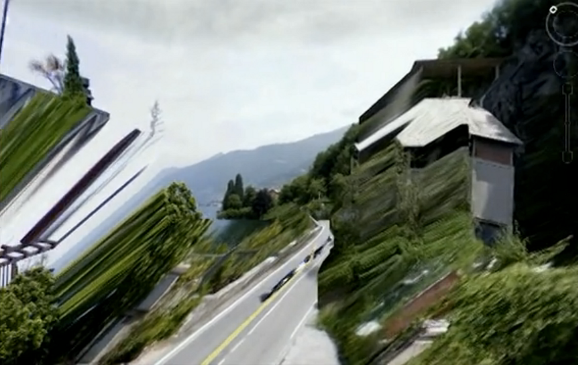
Featured in the Furtherfield Gallery exhibition are three works from the MOGA series: Lake Como Remix, The Comedy of Errors and 8-Bit Heaven.
Museum of Glitch Aesthetics was commissioned by Abandon Normal Devices for the 2012 AND Festival.

In conjunction with Shu Lea Cheang and Mark Amerika exhibition opening, Furtherfield is pleased to host Shu Lea Cheang’s Seeds Underground Party on Saturday 31 August, 2-5pm. Join us for a seed exchange party where packets of seeds change hands and go underground in the fields around Finsbury Park.
+ More information about the Seeds Underground Party.
To coincide with the exhibition, on Monday 02 September The White Building hosts a special talk by Shu Lea Cheang who will be in conversation with curator and writer Omar Kholeif.
+ More information about the Event.
Mark Amerika
Mark Amerika’s work has been exhibited internationally at venues such as the Whitney Biennial of American Art, the Denver Art Museum, the Institute of Contemporary Arts in London, and the Walker Art Center. In 2009-2010, The National Museum of Contemporary Art in Athens, Greece, hosted Amerika’s comprehensive retrospective exhibition entitled UNREALTIME. He is the author of many books including remixthebook (University of Minnesota Press, 2011) and his collection of artist writings entitled META/DATA: A Digital Poetics (The MIT Press, 2007). Amerika is a Professor of Art and Art History at the University of Colorado at Boulder and Principal Research Fellow in the Faculty of Humanities and Social Science at La Trobe University.
Shu Lea Cheang
As an artist, conceptualist, filmmaker, networker, Shu Lea Cheang (USA/France) constructs networked installation and multi-player performance in participatory impromptu mode. She drafts sci-fi narratives in her film scenario and artwork imagination. She builds social interface and open network that permits public participation. Engaged in media activism with transgressive plots for two decades (the 80s and 90s) in New York City, Cheang concluded her NYC period with the first Guggenheim Museum web art commission/collection BRANDON (1998-1999). Cheang has expanded her cross-genre-gender borderhack performative works since relocating in Eurozone in 2000. Currently situated in post-net BioNet zone, Cheang is composting the city, the net while mutating virus and hosting seeds underground parties.
Furtherfield Gallery
McKenzie Pavilion, Finsbury Park
London N4 2NQ
T: +44 (0)20 8802 2827
E: info@furtherfield.org
Furtherfield Gallery is supported by Haringey Council and Arts Council England.
This exhibition is sponsored by Rowans Tenpin Bowl, Carroll/Fletcher and Arts Catalyst.
Helen Varley Jamieson’s account of working collaboratively in Madrid at the Eclectic Tech Carnival. On a ‘sprint’, with five women coming together for a week to rebuild the group’s website, physically & remotely.
In the last week of June I went to Madrid for the Eclectic Tech Carnival (/ETC) website workweek – the collective effort of five women coming together for a week to rebuild the group’s website. This is sprint methodology, a concept that I first met in Agile software development, but one that is being increasingly applied as a successful creative collaboration methodology. During the workweek I blogged about the process and this article is an assemblage of the blog posts.
Thinking about the concept of the sprint, I realised that over the years, I’ve participated in a number of theatrical “sprints” although we didn’t call them that. In fact it could be argued that the normal development process for theatre productions in New Zealand is the sprint – a three or four week turnaround of devising/rehearsing/presenting. Except that it doesn’t usually continue the Agile process after the first sprint – evaluation, refinement then the next sprint and iteration – and as a result, the work is often undercooked. But theatre projects that better fit the sprint analogy are some of the workshop-performance processes that I’ve participated in at theatre festivals, where a small group comes together for a few days to create a performance, then some time later meets again in another situation, perhaps a slightly different configuration of people, for another sprint. Each sprint generates a stand-alone performance or work-in-process showing, as well as contributes to a larger evolving body of work that forms the whole collaborative project. Two such projects that I’ve been part of are Water[war]s and Women With Big Eyes (with the Magdalena Project).

Recently I participated remotely in a Floss Manuals sprint, developing a manual for CiviCRM (which is something that I use with the Magdalena Aoteroa site). In this sprint, a group of about 15 people met somewhere in the USA to create a manual for CiviCRM. A few more of us were online, doing things like copy-editing the content. Most of the time there were people active in the IRC channel, chatting about the project and other things going on around them, so I got a sense of their environment, time zone and the camaraderie generated by the intense process.
Sprinting seems like a very logical and effective way to work in many situations: in software development, where each sprint focuses on specific feature development, and allows for a lot of flexibility and adaptation as the project progresses; in theatre, where limited resources make it a practical way to work, and the time pressure forces us to be resourceful and imaginative and also with networks, such as the Eclectic Tech Carnival, whose organisers don’t get to meet physically very often. It also makes sense in the context of our hectic lives, to block out a week or a few days when we agree to put everything else on hold and commit to intense, focused work instead of trying to juggle and multitask, with deadlines pushing out and out.
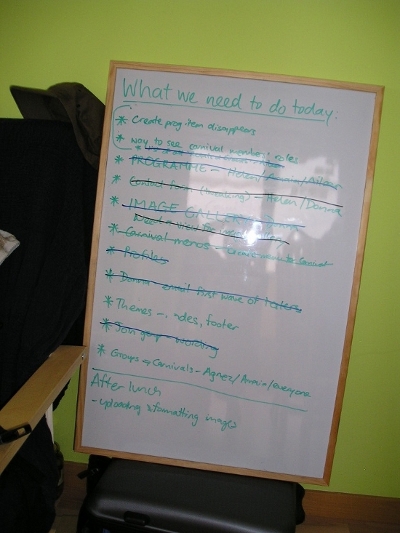
By halfway through the second day of the workweek, the wiki we used to plan and manage the project was filling up with tech specs, user requirements, design ideas, etc. We were getting encouraging emails from others in the network, and chatting to each other across the table and in the IRC. After lunch we did the new Drupal install and things seemed to be moving forward quickly in an organised and collaborative way.
Wednesday afternoon and the heat was oppressive; I put a little rack under my laptop because she was so hot, and my hands were too sweaty to use the trackpad. It wasn’t just Madrid’s weather that was making me sweat – we’d all been working hard on the new site since our late start in the morning (following on from a late night …). Agnes was busy developing the theme for the site, Aileen was working on profiles and user roles while Donna and Amaia were trying to configure mailing list integration and I was using the command line to drush download modules – much easier and quicker than the process of downloading, unpacking, ftp-ing and installing! And very exciting for me to use the command line, which I generally only get to do when hanging out with the /ETC crowd.

We were in that murky middle phase of the process: we’d done a lot of groundwork in terms of defining users, content types, general structure and the functionality required, but everything was still very bitsy and amorphous. But the installation of the test site had happened very easily yesterday, using drush, so that meant we now had something tangible to work with.
Working with Drupal can be pretty frustrating; it seems that every step of the way, another module is required to do what we want – then that module requires other modules, and then every little thing has to be finely configured to work just right with every other piece of the puzzle. From my previous experience with the Magdalena Aotearoa site, I knew we are doing a lot better this time in terms of defining what we need first, but some things we just can’t define until we know what’s possible, which we don’t really know for sure until we actually try it. We *think* we’re going to be able to do everything we want, but getting there isn’t simple. Also, the naming of different components and modules is sometimes ambiguous or confusing – the documentation ranges from really clear and detailed to non-existent. And some things just didn’t seem intuitive to me.
But, with five brains and our different complementary experiences and skills, I was still confident that we would have a new site by the end of Friday; maybe not a completely finished one, but a web site is never finished, is it?
On Friday morning the heat broke with a thunder storm and cooling welcome rain, but it didn’t last long. For some reason I woke up at 7.30am, ridiculously early as we hadn’t gone to bed until 2am. But I was wide awake so I enjoyed a couple of hours of quiet before everyone else awoke, drinking coffee and answering emails. The day before, Agnez and I had got up early to do yoga on the terrace, but the intense rain prevented that on Friday.
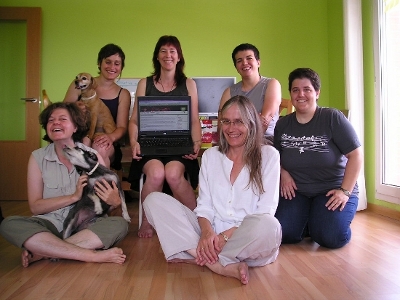
The test site was up and some of the others not present in Madrid were looking at it and trying things out. We’d solved a lot of problems but there were still a number of things not working. I had learned heaps about Drupal in the previous four days, particularly about organic groups, roles, permissions, and views. Altogether it is potentially incredibly flexible and powerful, however it takes time to work out how things need to be done and sometimes it is a confusing and circular process. Changing a setting in one place can stop something in a completely different place from working. However the combination of skills and experience between the five of us meant that usually one of us had at least an idea about how to do things and a couple of times we drew on external expertise via IRC or email.
On the last day, Agnez worked on finishing the theme while Aileen and I tried to work out why our groups are no longer displaying in the og_my view, and how to make the roles of group members visible. Donna had found that mailhandler and listhandler didn’t seem to be a practical way to integrate our mailman lists with Drupal after all – for the time being we’ll stick to the old system – and Amaia had been working on a way to create a programme for each event. The idea is that each /ETC event can be created as an organic group with the organisers having control over content and members within that group, but not being able to edit the rest of the site content. By Friday, we had this working pretty much how we wanted it.
We had planned a barbecue to celebrate the end of the workweek, but the rain prevented that. Instead, we ate inside then took turns to suffer humiliation and defeat with Wii Fitness (Amaia had clearly been practising!). In fact it wasn’t really the end of the sprint – rain again on Saturday morning meant that we decided to keep working longer and only went into the city in the afternoon, for a wander around and then the Gay Pride parade. On Sunday as we began to scatter back to our different parts of the globe, the site was still not live, as we were waiting for more feedback from testers and the finishing of the design themes. However, the site is essentially functional and should be live very soon.
The sprint process enabled us to achieve a considerable amount in a short space of time, sharing our knowledge and developing our skills. We also had great conversations over meals, explored Madrid and Colmenar Viejo, learned how to make Spanish tortilla, attempted a bit of Spanish, went swimming and did yoga. I even fitted in a performance on the first night, with Agnez, and dinner with friends another night. It’s amazing what you can do when you put the rest of your life on hold for a week; the only downside is the catching up afterwards.